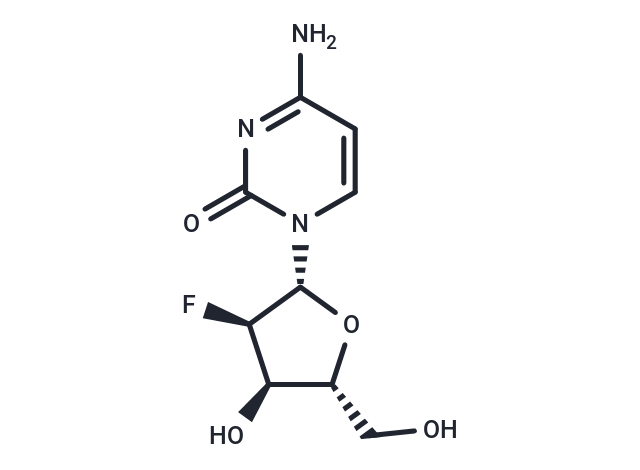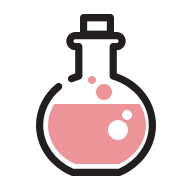- Remove All
 Your shopping cart is currently empty
Your shopping cart is currently empty
Shopping Cart
2'-Deoxy-2'-fluorocytidine
Catalog No. T38238Cas No. 10212-20-1
2'-Deoxy-2'-fluorocytidine, a nucleoside analog, is a potent inhibitor of Crimean-Congo hemorrhagic fever virus (CCHFV) replication and can act synergistically with T705 to enhance the antiviral effects on CCHFV replication[1]. It exhibits antiviral activity with EC50 values of 61 nM and 31 nM against CCHFV and CCHFV/ZsG in Huh7 cells, respectively, and has a CC50 of >50.0 μM in Huh7 cells[1].
[1]. Stephen R Welch, et al. Identification of 2'-deoxy-2'-fluorocytidine as a potent inhibitor of Crimean-Congo hemorrhagic fever virus replication using a recombinant fluorescent reporter virus. Antiviral Res. 2017 Nov;147:91-99.

2'-Deoxy-2'-fluorocytidine
Catalog No. T38238Cas No. 10212-20-1
2'-Deoxy-2'-fluorocytidine, a nucleoside analog, is a potent inhibitor of Crimean-Congo hemorrhagic fever virus (CCHFV) replication and can act synergistically with T705 to enhance the antiviral effects on CCHFV replication[1]. It exhibits antiviral activity with EC50 values of 61 nM and 31 nM against CCHFV and CCHFV/ZsG in Huh7 cells, respectively, and has a CC50 of >50.0 μM in Huh7 cells[1].
[1]. Stephen R Welch, et al. Identification of 2'-deoxy-2'-fluorocytidine as a potent inhibitor of Crimean-Congo hemorrhagic fever virus replication using a recombinant fluorescent reporter virus. Antiviral Res. 2017 Nov;147:91-99.
[1]. Stephen R Welch, et al. Identification of 2'-deoxy-2'-fluorocytidine as a potent inhibitor of Crimean-Congo hemorrhagic fever virus replication using a recombinant fluorescent reporter virus. Antiviral Res. 2017 Nov;147:91-99.
| Pack Size | Price | Availability | Quantity |
|---|---|---|---|
| 100 mg | $29 | In Stock | |
| 500 mg | $59 | In Stock |
Bulk & Custom
Add to Cart
Questions
View MoreSelect Batch
Purity:99.03%
Contact us for more batch information
All TargetMol products are for research purposes only and cannot be used for human consumption. We do not provide products or services to individuals. Please comply with the intended use and do not use TargetMol products for any other purpose.Product Introduction
Bioactivity
Chemical Properties
| Description | 2'-Deoxy-2'-fluorocytidine, a nucleoside analog, is a potent inhibitor of Crimean-Congo hemorrhagic fever virus (CCHFV) replication and can act synergistically with T705 to enhance the antiviral effects on CCHFV replication[1]. It exhibits antiviral activity with EC50 values of 61 nM and 31 nM against CCHFV and CCHFV/ZsG in Huh7 cells, respectively, and has a CC50 of >50.0 μM in Huh7 cells[1]. [1]. Stephen R Welch, et al. Identification of 2'-deoxy-2'-fluorocytidine as a potent inhibitor of Crimean-Congo hemorrhagic fever virus replication using a recombinant fluorescent reporter virus. Antiviral Res. 2017 Nov;147:91-99. |
| Targets&IC50 | CCFHV:61 ± 18 nM(EC50) |
| In vitro | 2'-Deoxy-2'-fluorocytidine exhibits antiviral activity with 50% effective concentrations (EC50) of 61 nM against CCHFV and 31 nM against CCHFV/ZsG in Huh7 cells and shows a 50% cytotoxicity concentration (CC50) of >50.0 μM in Huh7 cells[1]. |
| Molecular Weight | 245.21 |
| Formula | C9H12FN3O4 |
| Cas No. | 10212-20-1 |
| Smiles | Nc1ccn([C@@H]2O[C@H](CO)[C@@H](O)[C@H]2F)c(=O)n1 |
| Relative Density. | 1.82 g/cm3 |
Storage & Solubility Information
| Storage | Powder: -20°C for 3 years | In solvent: -80°C for 1 year | Shipping with blue ice. | ||||||||||||||||||||||||||||||||||||||||
| Solubility Information | DMSO: 50 mg/mL (203.91 mM), Sonication is recommended. H2O: 5 mg/mL (20.39 mM), Sonication and heating to 60℃ are recommended. | ||||||||||||||||||||||||||||||||||||||||
Solution Preparation Table | |||||||||||||||||||||||||||||||||||||||||
H2O/DMSO
DMSO
| |||||||||||||||||||||||||||||||||||||||||
Calculator
In Vivo Formulation Calculator (Clear solution)
Please enter your animal experiment information in the following box and click Calculate to obtain the mother liquor preparation method and in vivo formula preparation method:
Mother liquor preparation method: 2 mg of drug dissolved in 50 μL DMSO (mother liquor concentration of 40 mg/mL), if you need to configure a concentration that exceeds the solubility of the product, please contact us first.
(mother liquor concentration of 40 mg/mL), if you need to configure a concentration that exceeds the solubility of the product, please contact us first.
Preparation method for in vivo formula: Take 50 μL DMSO main solution, add 300 μLPEG300
main solution, add 300 μLPEG300 mix well and clarify, then add 50 more μL Tween 80, mix well and clarify, then add 600 more μLddH2O
mix well and clarify, then add 50 more μL Tween 80, mix well and clarify, then add 600 more μLddH2O mix well and clarify
mix well and clarify
For Reference Only. Please develop an appropriate dissolution method based on your laboratory animals and route of administration.
Dose Conversion
You can also refer to dose conversion for different animals. More Dose Conversion
Tech Support
Please see Inhibitor Handling Instructions for more frequently ask questions. Topics include: how to prepare stock solutions, how to store products, and cautions on cell-based assays & animal experiments, etc
Keywords
NucleosideAntimetaboliteNucleoside Antimetabolite/AnalogNucleoside Antimetabolitenucleoside analogInhibitorinhibitInfluenzaVirusInfluenza VirusCrimean-Congo hemorrhagic fever virus (CCHFV)Crimean-Congo hemorrhagic feverAntiviral,CCHFVAnalog2'Deoxy2'fluorocytidine2'-Deoxy-2'-fluorocytidine2' Deoxy 2' fluorocytidine
Related Tags: buy 2'-Deoxy-2'-fluorocytidine | purchase 2'-Deoxy-2'-fluorocytidine | 2'-Deoxy-2'-fluorocytidine cost | order 2'-Deoxy-2'-fluorocytidine | 2'-Deoxy-2'-fluorocytidine chemical structure | 2'-Deoxy-2'-fluorocytidine in vitro | 2'-Deoxy-2'-fluorocytidine formula | 2'-Deoxy-2'-fluorocytidine molecular weight

Copyright © 2015-2025 TargetMol Chemicals Inc. All Rights Reserved.



